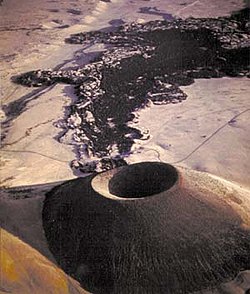Description
Alexander von Humboldt observed in 1823 that geologically young volcanoes are not distributed uniformly across the Earth's surface, but tend to be clustered into specific regions. Young volcanoes are rarely found within cratons, but are characteristic of subduction zones, rift zones, or in ocean basins. Intraplate volcanoes are clustered along hotspot traces. [2]
Within regions of volcanic activity, volcanic fields are clusters of volcanoes that share a common magma source. [3] Unlike a large volcano with satellite or subsidiary vents, a volcanic field's vents have their own source of magma, possibly of different compositions (such as basalt and rhyolite), and these vents may span an area of thousands of square miles. [4] Scoria cones are particularly prone to cluster into volcanic fields, which are typically 30–80 kilometers (19–50 miles) in diameter and consist of several tens to several hundred individual cones. The unusually large Trans-Mexican Volcanic Belt has nearly 1000 cones covering an area of 60,000 square kilometers (23,000 sq mi). [5]
This page is based on this
Wikipedia article Text is available under the
CC BY-SA 4.0 license; additional terms may apply.
Images, videos and audio are available under their respective licenses.




